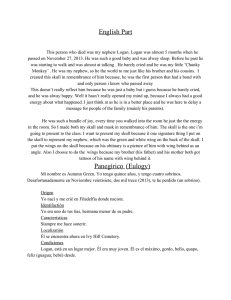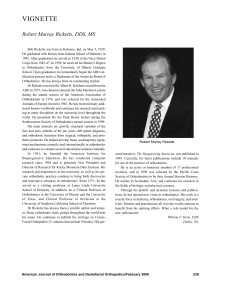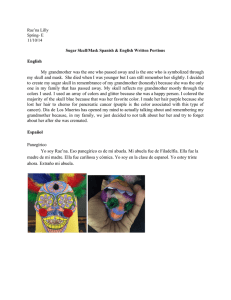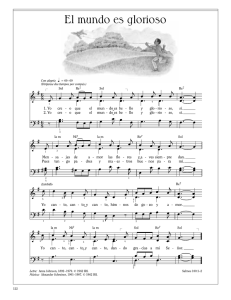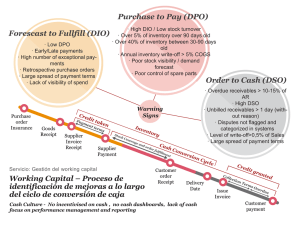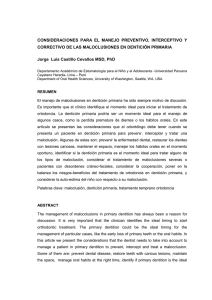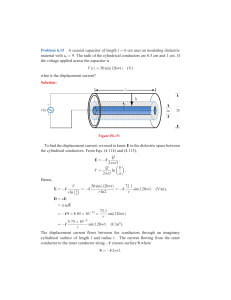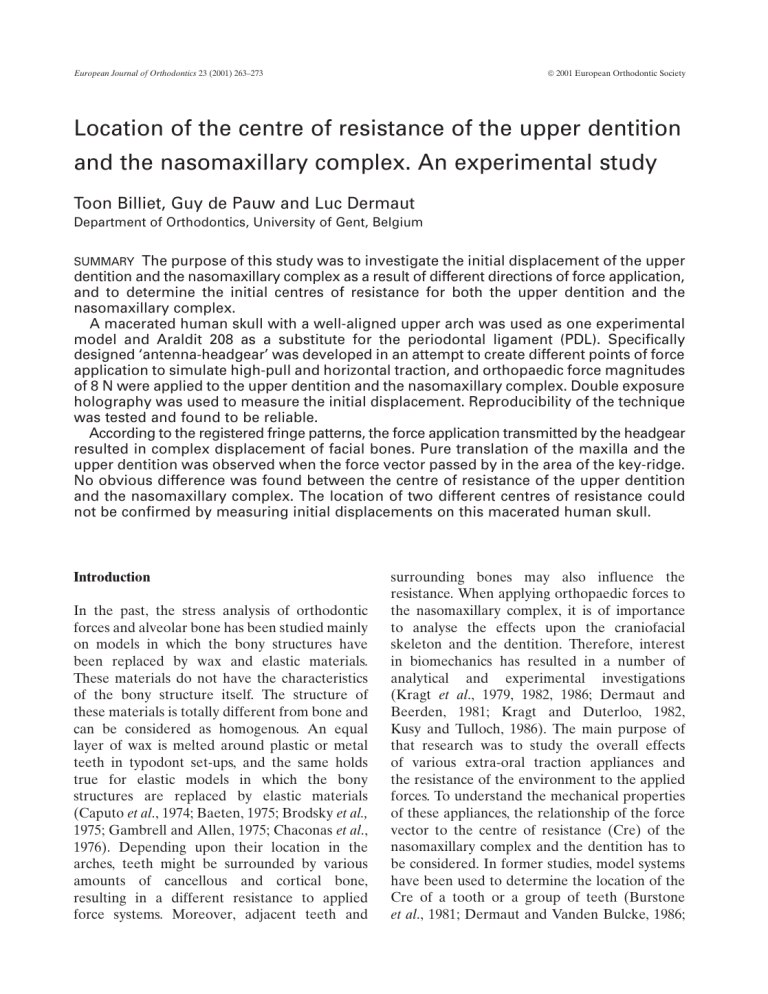
2001 European Orthodontic Society European Journal of Orthodontics 23 (2001) 263–273 Location of the centre of resistance of the upper dentition and the nasomaxillary complex. An experimental study Toon Billiet, Guy de Pauw and Luc Dermaut Department of Orthodontics, University of Gent, Belgium The purpose of this study was to investigate the initial displacement of the upper dentition and the nasomaxillary complex as a result of different directions of force application, and to determine the initial centres of resistance for both the upper dentition and the nasomaxillary complex. A macerated human skull with a well-aligned upper arch was used as one experimental model and Araldit 208 as a substitute for the periodontal ligament (PDL). Specifically designed ‘antenna-headgear’ was developed in an attempt to create different points of force application to simulate high-pull and horizontal traction, and orthopaedic force magnitudes of 8 N were applied to the upper dentition and the nasomaxillary complex. Double exposure holography was used to measure the initial displacement. Reproducibility of the technique was tested and found to be reliable. According to the registered fringe patterns, the force application transmitted by the headgear resulted in complex displacement of facial bones. Pure translation of the maxilla and the upper dentition was observed when the force vector passed by in the area of the key-ridge. No obvious difference was found between the centre of resistance of the upper dentition and the nasomaxillary complex. The location of two different centres of resistance could not be confirmed by measuring initial displacements on this macerated human skull. SUMMARY Introduction In the past, the stress analysis of orthodontic forces and alveolar bone has been studied mainly on models in which the bony structures have been replaced by wax and elastic materials. These materials do not have the characteristics of the bony structure itself. The structure of these materials is totally different from bone and can be considered as homogenous. An equal layer of wax is melted around plastic or metal teeth in typodont set-ups, and the same holds true for elastic models in which the bony structures are replaced by elastic materials (Caputo et al., 1974; Baeten, 1975; Brodsky et al., 1975; Gambrell and Allen, 1975; Chaconas et al., 1976). Depending upon their location in the arches, teeth might be surrounded by various amounts of cancellous and cortical bone, resulting in a different resistance to applied force systems. Moreover, adjacent teeth and surrounding bones may also influence the resistance. When applying orthopaedic forces to the nasomaxillary complex, it is of importance to analyse the effects upon the craniofacial skeleton and the dentition. Therefore, interest in biomechanics has resulted in a number of analytical and experimental investigations (Kragt et al., 1979, 1982, 1986; Dermaut and Beerden, 1981; Kragt and Duterloo, 1982, Kusy and Tulloch, 1986). The main purpose of that research was to study the overall effects of various extra-oral traction appliances and the resistance of the environment to the applied forces. To understand the mechanical properties of these appliances, the relationship of the force vector to the centre of resistance (Cre) of the nasomaxillary complex and the dentition has to be considered. In former studies, model systems have been used to determine the location of the Cre of a tooth or a group of teeth (Burstone et al., 1981; Dermaut and Vanden Bulcke, 1986; 264 Dermaut et al., 1986a,b; Vanden Bulcke et al., 1987). These investigations provided insight into the displacement characteristics of the dentition to applied forces. In particular, the point of force application was found to be an important factor in tooth displacement. The location of the Cre of the maxillary complex offers important information with respect to the use of headgearactivators. Differences in the direction of orthopaedic forces, as well as the point of force application may produce different displacement patterns of the complex and stress distribution in the maxillofacial sutures of the nasomaxillary complex. Kragt et al. (1982, 1986), Tanne et al. (1993), and Tanne and Matsubara (1996) reported a difference in force distribution after application of various force systems. These findings can be explained by the differences in the location and direction of force vectors relative to the Cre of the nasomaxillary complex. According to the literature, there is little evidence concerning the location of the Cre. The experimental determination of the Cre of the upper first molar and of the anterior teeth has already been carried out (Dermaut et al., 1986a,b; Dermaut and Vanden Bulcke, 1986; Vanden Bulcke et al., 1987). Teuscher (1986), and Stöckli and Teuscher (1994) made a distinction between the Cre of the upper dentition and of the maxilla. They defined the Cre of the maxilla at the postero-superior area of the zygomaticomaxillary suture, whereas the Cre of the upper dentition was situated between the roots of the upper premolars. The location of these points was determined by observed changes in craniofacial morphology evaluated on lateral cephalograms of different patients treated with an activator. The defined centres of resistance have to be understood as ‘average’ points. Moreover, the effect of normal growth, which may differ from patient to patient, might also affect the position of these points. Initial stress analysis induced by headgearactivator therapy, might be investigated on a skull by changing the point and direction of force application. Initial displacement is the result of the resistance of the nasomaxillary complex to different force application systems in which the biological parameters are left constant by using the same skull. Besides Teuscher (1986) and T. B I L L I E T E T A L . Stöckli and Teuscher (1994) a few other clinical studies have offered information on the localization of the Cre of the nasomaxillary complex. Over the years, there has been an increased interest in studies in which extraoral traction has been tested on different human skulls models. Strain gauges, photo-elastic models and finite element analysis are often used as measuring methods (Caputo et al., 1974; Hata et al., 1987; Tanne et al., 1993). In a finite element study, Tanne et al. (1995) suggested that the Cre of the nasomaxillary complex was located on the postero-superior ridge of the pterygomaxillary fissure. Lee et al. (1997) concluded, in a laser holography study on a human dry skull, that a translation was reached when the point of anterior force application was 15 mm above and directed 20 degrees downwards to the occlusal plane along with palatal expansion. The aim of this study was to investigate the initial displacement of the upper dentition and the nasomaxillary complex as a result of different directions of force, and to determine the initial centres of resistance for both the upper dentition and the nasomaxillary complex. In the present investigation a non-invasive and highly accurate holographic method was used which allowed the precise detection of very subtle initial reactions of hard tissue after force application. From a clinical viewpoint, exact information on the possible effects of force application is of outmost importance for the orthodontist, since initial displacement may be indicative. Materials and methods A macerated human skull (aged 16 years), with well-aligned upper permanent teeth, was used as the experimental model. The teeth were carefully removed from the skull and their bony sockets cleaned with acetone to remove residue. During this procedure an attempt was made to avoid any damage to the alveolar bone. Only one skull was used so that all biological and environmental variables were left constant except those to be investigated. Since all parameters remained unchanged, the only differences which were measured, were due to the differences in force 265 C E N T R E O F R E S I S TA N C E A N D U P P E R D E N T I T I O N Figure 1 Experimental set-up with antenna headgear, splint and metal plate; example of high-pull traction to the dentition. direction. The periodontal ligament (PDL) was replaced by a thin layer of resin (Araldit 208, CM Technics) injected into the empty sockets, following which the teeth were carefully repositioned. This special resin, when mixed with the harder 956 (CM Technics) at a ratio of 10 to 1, displays nearly the same elastic properties as the human periodontium (Dijkman, 1969). In the present study, an artificial PDL was used in an attempt to simulate more accurately the biological situation. Although the elastic modulus of Araldit is not provided by the manufacturers, laboratory experiments have shown forces of 60 kg/cm2, which is comparable to the values described by Diemer and Hofmann (Dijkman, 1969). Orthodontic molar bands carrying headgear tubes were cemented on the maxillary first permanent molars and an identical tube was glued directly to the maxillary bone. An acrylic splint was fabricated to embrace the upper dentition and a rigid metal plate was fixed to the anterior part of the splint, in an attempt to register accurately initial displacement by means of holography (Figures 1 and 2). With a metal plate, an extension was made of the dentition. For the same rotation it was obvious that the further away from the clasping point (point of fixation), the larger the number of fringes. The metal plate enabled improved visualization of the differences between the various points of force application. Two facebows, which allowed different points of force application, were constructed. In a first series of experiments a facebow was used to register horizontal traction at different vertical levels (Figure 3). For vertical traction a second facebow was constructed to apply vertical forces on different sagittal positions (Figure 4). These last measurements were carried out in a second experiment. Different hooks were soldered at various levels of the bows to support a nylon wire and to create various points of force application. The skull was fixed to a heavy metal support by a modelling compound shield covering the frontal and occipital bone. Traction was transmitted to the hooks by means of a nylon wire attached to a weight carrier dish via wheels that could be adjusted to simulate high-pull and horizontal traction. A force magnitude of 8 N was produced by placing a dish weight on the carrier. 266 T. B I L L I E T E T A L . Figure 2 Example of horizontal traction to the maxilla. Figure 3 Points of force application (1–7) to the maxilla and the dentition with horizontal traction. In recent years, holography has been increasingly used in biomechanical research, especially in orthodontics. In this procedure, coherent and monochromatic laser light is employed for recording an object surface on a photosensitive emulsion of the holographic plate. This plate is illuminated by a split laser beam; one beam (the reference) is directed towards the holographic plate and the other reflected from the object surface. By superimposition of two coherent light waves, one of which is reflected from the undeformed and the other from the deformed object surface, spatial interference fields are formed by interference of these waves. In the plane of the hologram these fields are reduced to a system of interference fringes. This fringe pattern yields information concerning the magnitude of the displacement at the surface of the object and the direction of displacement. A 10 mW He-Ne laser (λ = 0.6328 µm) was used and the laser beams were exposed on holographic plates (Agfa Gevaert) consisting of a highly sensitized emulsion that coated the glass plates. A double exposure technique was used. The unloaded skull was exposed for 10 seconds, the desired force was then applied for 10 minutes and the same holographic plate was then exposed for a further 10 seconds. A relaxation 267 C E N T R E O F R E S I S TA N C E A N D U P P E R D E N T I T I O N period of 15 minutes was allowed before the next hologram was taken. A frontal hologram was taken for each traction: seven points of force application for the high-pull traction and seven points for the horizontal traction. To test the reliability of the method, five holograms from six different force systems were taken following loading of 6 N. A minimal amount of force was needed to visualize the creation of fringes. To measure displacements in a reproducible way, it was found that a minimum force of 6 N was needed. In the final experiment, this force was increased to 8 N in an attempt to improve the visualization of the amount and direction of the fringes. Results Reliability of the method Since the quantitative calculation of the initial displacement of the upper dentition and the nasomaxillary complex uses the counting of fringes with regard to a chosen reference point, the accuracy depends upon the visibility and outline of the dark fringes. The fixation of the skull was tested under different loading and proved to be reliable. A series of five holograms registering the application of an orthopaedic force of 6 N under six different loading systems showed a highly comparable fringe pattern. The total amount of fringes over the whole length of the skull differed by a maximum of one unit (Table 1). The analysis of the fringe patterns on the maxillary complex and the upper dentition in case of high-pull and horizontal traction revealed the following findings. High-pull traction (Figure 4). A force application anterior to the key-ridge always created an initial counterclockwise rotation of the dentition and of the maxillary complex indicated by the number of fringes (Figure 5). Within one maxillofacial bone the fringe patterns showed regular images. In the sutures between the bones this regular pattern was interrupted, indicating that the sutures transmitted orthopaedic forces resulting in differential displacement directions. When the force vector approximated the presumed Cre, the magnitude of the rotational displacement was less although a force direction through the Cre should create a translation. A force application posterior to the Cre again created a higher number of fringes, indicating a clockwise rotation. The difference of the point of force application between the dental splint and the maxilla did not seem to be of great importance when comparing the magnitudes of the initial displacement (Figure 6). The rigid fixation of the dentition by the maxillary splint seemed to transmit the Table 1 Error of the method tested by comparing the magnitude of the initial displacement (10–6m) in 5 holograms (n = 5) taken from the same situation on 3 randomly selected different points of force application (P1 – P3). x̄ = mean displacement, r = range 268 T. B I L L I E T E T A L . Figure 4 Points of force application (1–7) to the dentition and the maxilla with high-pull traction. Figure 5 Example of a series of seven holograms illustrating the initial displacement of the nasomaxillary complex with high-pull traction on the dentition. 269 C E N T R E O F R E S I S TA N C E A N D U P P E R D E N T I T I O N Figure 6 Diagram illustrating the magnitude of displacement for different points of force application with high-pull traction on the dentition and the maxilla (CCW = counter-clockwise rotation; CW = clockwise rotation). applied forces directly to the maxilla without a significant difference in initial displacement of the dentition. Horizontal traction (Figure 3). The initial orthopaedic displacement of the maxilla after horizontal force application was comparable with the displacement after high-pull traction as far as the magnitude of the displacement was concerned. A force application beneath the zygomatic process of the maxilla created a clockwise rotation of the maxilla, while a force application above the zygomatic process resulted in a counter-clockwise rotation of the maxilla. The smallest rotation was observed with a force direction just below the zygomatic process of the maxilla (Figure 7). A typical circular fringe pattern as described by Lee et al. (1997) was observed at the key-ridge of the maxilla with high-pull, as well as horizontal traction at different points of force application (Figure 8). These circular fringes were the result of a lateral translation of the centre of the zygomatic arch. By combining the force levels of horizontal and high-pull traction with the least fringes, the Cre was constructed (Figure 9). Translation was considered to occur in this experimental set-up where the least fringes were registered. Both the Cre defined by forces applied to the splinted teeth and to the maxilla were located near the lower border of the zygomatic process of the maxilla. There were no significant differences between the initial displacement of the upper dentition and the maxillary complex. The magnitude as well as the direction of the initial displacement was comparable. The analysis of the fringe pattern could not distinguish a difference between a dental and a skeletal Cre. Discussion The use of a macerated human skull as a model to investigate the effect of force application on teeth and bone deals with the following hypothesis: by applying a force on a tooth, the PDL is stretched on one side and squeezed on the other. Bone apposition by the formation of 270 T. B I L L I E T E T A L . Figure 7 Diagram illustrating the magnitude of displacement for different points of force application with horizontal traction on the dentition and the maxilla (CW = clockwise rotation; CCW = counter-clockwise rotation). Figure 9 The Cre defined by the intersection of the action lines after horizontal (HT) and high-pull (HPT) force application inducing translation of the maxilla. Figure 8 Typical circular fringe pattern observed at different force levels at the zygomatic area. bone spiculae and bone resorption on the opposite side might be the result. This biological phenomenon creates tooth movement and rebuilding of the alveolar process. Initial displacement registered on the skull might provide C E N T R E O F R E S I S TA N C E A N D U P P E R D E N T I T I O N an indication for the expected longitudinal effect. The influence of force application on the craniofacial complex has been investigated extensively in clinical and in vitro situations. It is difficult to study the effect of the different force parameters in the clinical situation. Therefore, in the last decades, an attempt has been made to investigate the influence of orthopaedic forces on different in vitro models. In the present study, a macerated human skull was used to evaluate the initial orthopaedic displacements of the maxilla and the upper dentition in a posterior direction. The complex architecture of the skull with combinations of trabecular and cortical bone, as well as sutures and teeth together with changes in elasticity of all these structures, make the dry skull a more valuable model than those constructed by using photoelastic materials. Nevertheless, the absence of soft tissues in the sutures, and of the PDL, the macerating process, humidity and other factors may have consequences in the biomechanical behaviour. To approximate reality, Araldit was used as a substitute for the PDL (Dijkman, 1969). In previous studies the initial displacement of teeth on a dry skull by headgear (Dermaut et al., 1986a,b) and by intrusive mechanics (Dermaut and Vanden Bulcke, 1986) was found to be comparable to the clinical displacement (Worms et al., 1973; Nanda, 1981), indicating that the use of a macerated skull might be a valuable model. The centre of rotation might be defined by the intersection of two displacement vectors (De Clerck et al., 1990; Govaert and Dermaut, 1997). However, a recent study (De Pauw and Dermaut, 1998), clearly showed that the use of the centre of rotation is susceptible to an important error. Small differences in the direction of the displacement vectors may result in a considerable change of the centre of rotation. Therefore, in this study initial displacement vectors were used instead of centres of rotation. The magnitude and the direction of the initial displacement vector immediately after force application will indicate the differential reactions of the bones as a result of the force system used. A force application through the Cre of the 271 maxilla will create a pure translation, so an exact definition of the position of the Cre of the maxilla is important in order to obtain the presumed maxillary displacement. Poulton (1959, 1967), Barton (1972), and Bench et al. (1978) defined different displacements of the maxilla after headgear force application on patients. According to Poulton (1959, 1967) the Cre of the maxilla is situated at the apex of the second premolar in the maxilla. Bench et al. (1978) reported its position to be in the most superior point of the fossa sphenopalatina, while Barton (1972) linked the position of the Cre of the maxilla to the number of teeth involved in the appliance design. They all applied headgear therapy to the upper first molars in different patients. In the present experimental set-up headgear traction was applied to a splint and directly to the maxilla in the same skull. According to earlier experiments using laser measuring techniques (Dermaut and Beerden, 1981; Dermaut and Vanden Bulcke, 1986; Dermaut et al., 1986a,b) it has been found that bone displacements within a skull, after force application, are due to displacements in the sutures, rather than to bone bending within the same bone unit. For practical reasons tubes were glued on the alveolar process in the area of the first molars. This location is not critical as the localisation of the Cre of the maxilla is determined by the point of force application (facebow hooks) instead of the position of the tube. It is obvious therefore that comparison of the findings is inappropriate. Lee et al. (1997) in a comparable dry skull study applied anterior traction to a rapid maxillary expansion appliance in an attempt to transmit the applied force to the entire maxilla. When the screw was activated and a protraction force was exerted, the Cre of the maxilla was reported to be located approximately in the same area as that in this study. They, however, did not investigate the Cre of the upper dentition. Teuscher (1986), and Stöckli and Teuscher (1994), distinguished two centres of resistance: one for the maxilla and one for the dentition. By directing the extra-oral force vector between the respective centres of resistance, differential reaction patterns on the maxilla and the dentition 272 T. B I L L I E T E T A L . cervical and headgear appliances. American Journal of Orthodontics 69: 527–539 might be expected. In this study, no clear difference in initial displacement (magnitude and direction) between maxilla and dentition was found. De Clerck H, Dermaut L R, Timmerman H 1990 The value of the macerated skull as a model used in orthopaedic research. European Journal of Orthodontics 12: 263–271 Conclusions De Pauw G, Dermaut L 1998 The value of the centre of rotation in the displacement of tooth and bone structure. European Journal of Orthodontics 19: 447 (Abstract) The results of this investigation showed that the region of the Cre of the maxilla was situated underneath the zygomatic process of the maxillary complex. A force vector applied through this region induced initially nearly pure translation of the maxilla in high-pull as well as with posterior horizontal traction. The Cre of the maxilla defined by Teuscher was situated in a more upward and posterior position. The localisation of two different Cre as suggested by Teuscher (1986), and Stöckli and Teuscher (1994) in activator-headgear therapy could not be confirmed by measuring initial displacements on a macerated human skull. Address for correspondence Professor Dr Luc Dermaut Department of Orthodontics University of Gent De Pintelaan 185 9000 Gent Belgium References Baeten L R 1975 Canine retraction: a photoelastic study. American Journal of Orthodontics 67: 11–23 Barton J J 1972 High-pull headgear versus cervical traction: a cephalometric comparison. American Journal of Orthodontics 62: 517–529 Bench R W, Gugino C G, Hilgers J J 1978 Bioprogressive therapy. Journal of Clinical Orthodontics 12: 48–69 Brodsky J F, Caputo A A, Furstman L L 1975 A photoelastic-histopathological correlation. American Journal of Orthodontics 67: 1–10 Burstone C J, Pryputniewicz R J, Weeks R 1981 Center of resistance of the human mandibular molars. Journal of Dental Research 60: 515 (Abstract) Caputo A A, Chaconas S J, Hayashi R K 1974 Photoelastic visualisation of orthodontic forces during canine retraction. American Journal of Orthodontics 65: 250–259 Chaconas S J, Caputo A A, Davis J C 1976 The effects of orthopedic forces on the craniofacial complex utilizing Dermaut L R, Beerden L 1981 The effects of Class II elastic force on dry skull measured by holographic interferometry. American Journal of Orthodontics 79: 296–303 Dermaut L R, Vanden Bulcke M 1986a Evaluation of intrusive mechanics of the type ‘segmented arch’ on a macerated human skull using the laser reflection technique and holographic interferometry. American Journal of Orthodontics 89: 251–263 Dermaut L R, Kleutghen J P, De Clerck H J 1986b Experimental determination of the center of resistance of the upper first molar in a macerated, dry human skull submitted to horizontal headgear traction. American Journal of Orthodontics and Dentofacial Orthopedics 90: 29–36 Dijkman J F 1969 The distribution of forces in orthodontic treatment. Thesis, University of Nijmegen, The Netherlands Gambrell S C, Allen J M Jr 1976 Stress concentrations at the apex of pinned, implanted teeth. Journal of Dental Research 55: 59–65 Govaert L, Dermaut L 1997 The importance of humidity in the in vitro study of the cranium with regard to initial bone displacement after force application. European Journal of Orthodontics 19: 423–430 Hata S, Itoh T, Nakagawa K, Ichikawa K, Matsumoto M, Chaconas S J 1987 Biomechanical effects of maxillary protraction on the craniofacial complex. American Journal of Orthodontics and Dentofacial Orthopedics 91: 305–311 Kragt G, Duterloo H S 1982 The initial effects of orthopedic forces: a study of alterations in the craniofacial complex of a macerated human skull owing to high-pull headgear traction. American Journal of Orthodontics 81: 57–64 Kragt G, Ten Bosch J J, Borsboom P C F 1979 Measurement of bone displacement in a macerated human skull induced by orthodontic forces: a holographic study. Journal of Biomechanics 12: 905–910 Kragt G, Duterloo H S, Ten Bosch J J 1982 The initial reaction of a macerated human skull caused by orthodontic cervical traction determined by laser metrology. American Journal of Orthodontics 81: 49–56 Kragt G, Duterloo H S, Algra A M 1986 Initial displacements and variations of eight human child skulls owing to high-pull headgear traction determined with laser holography. American Journal of Orthodontics 89: 399–406 Kusy R P, Tulloch J F C 1986 Analysis of moment/force ratios in the mechanics of tooth movement. American Journal of Orthodontics and Dentofacial Orthopedics 90: 127–131 C E N T R E O F R E S I S TA N C E A N D U P P E R D E N T I T I O N Lee K G, Ryu Y K, Park Y C, Rudolph D J 1997 A study of holographic interferometry on the initial reaction of maxillofacial complex during protraction. American Journal of Orthodontics and Dentofacial Orthopedics 111: 623–632 Nanda R 1981 The differential diagnosis and treatment of excessive overbite. Dental Clinics of North America 25: 69–84 Poulton D R 1959 Changes in Class II malocclusion with and without occipital headgear therapy. Angle Orthodontist 34: 181–193 Poulton D R 1967 The influence of extraoral traction. American Journal of Orthodontics 53: 8–18 Stöckli P M, Teuscher U M 1994 Combined activator headgear orthopedics. In: Graber M, Vanarsdall R L (eds) Orthodontics: current principles and techniques. Mosby, St Louis Tanne K, Matsubara S 1996 Association between the direction of orthopedic force and sutural responses in the nasomaxillary complex. Angle Orthodontist 66: 125–130 273 Tanne K, Matsubara S, Sakuda M 1993 Stress distributions in the maxillary complex from orthopedic headgear forces. Angle Orthodontist 63: 111–118 Tanne K, Matsubara S, Sakuda M 1995 Locations of the centre of resistance for the nasomaxillary complex studied in a three-dimensional finite element model. British Journal of Orthodontics 22: 227–232 Teuscher U M 1986 An appraisal of growth and reaction to extraoral anchorage: simulation of orthodonticorthopedic results. American Journal of Orthodontics 89: 113–121 Vanden Bulcke M, Burstone C J, Sachdeva R C, Dermaut L R 1987 Location of the centers of resistance for anterior teeth during retraction using the laser reflection technique. American Journal of Orthodontics and Dentofacial Orthopedics 91: 375–384 Worms F W, Isaacson R J, Speider T M 1973 A concept and classification of centers of rotation and extraoral force systems. Angle Orthodontist 43: 384–401
